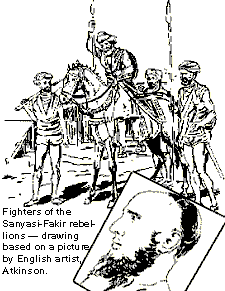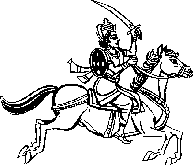
Dimdima
Online Children's Magazine from India

Dimdima
Online Children's Magazine from India
 Right From 1757 when the Battle of Plassey took place, to 1857, hardly a year passed without resistance to the expansion and consolidation of the British power in India. Besides the battles the local rulers fought for their territorial rights and the occasional revolts by the sepoys, the British had to put up with civil rebellions, tribal uprisings and peasant movements in various parts of the country.
Right From 1757 when the Battle of Plassey took place, to 1857, hardly a year passed without resistance to the expansion and consolidation of the British power in India. Besides the battles the local rulers fought for their territorial rights and the occasional revolts by the sepoys, the British had to put up with civil rebellions, tribal uprisings and peasant movements in various parts of the country.
Some of the early civil rebellions started off as movements of religious reform or purification. Later they became more broad-based and championed the cause of peasants. This brought them in conflict with the zamindars, money-lenders and finally the British authority. The Farazi Movement of Bengal led by Dadu Mian and the Wahabi Movement which spread across the country are two notable examples of how what began essentially as religious movements soon became uprisings against the British Raj.
The Farazi sect was founded by Haji Shariatullah of Faridpur in East Bengal. His son, Dadu Mian (1819 -1860) united the cultivators against the tyranny and illegal exactions of landlords. His was the first ever no-tax campaign against the British Government for he believed that all lands belonged to God and no man had the right to demand any taxes. He boycotted courts and himself administered summary justice.
Several times Dadu Mian was tried on various charges such as unlawful assembly, abduction, plunder and even murder. On each occasion he was acquitted as the prosecution found it impossible to get witnesses to give evidence against Dadu Mian.
The Wahabis, a sect which called upon Muslims to return to pure Islam, carried on an organized struggle against British rule. Its leader Saiyid Ahmed of Rae Bareli (1786 -1831) was determined to restore Muslim power in India. Wahabis were most active from 1829 to 1870. Every rank of Muslim society - priests, merchants, soldiers, preachers and peasants took part in the movement which was widespread in Bengal, Bihar, Punjab, North West Frontier Provinces and also in Hyderabad and Madras. Such was the popular appeal of the movement that in the Deccan, women sold their jewels and donated the proceeds to the movement.
In the beginning Hindus were suspicious of the motives of the Wahabis. However, as the movement became increasingly political and anti-British, it gained sympathy and support of the Hindus some of whom were detained for their pro-Wahabi activities.
The movement which was undoubtedly religious in its origin, assumed the character of a class struggle in some places, especially in Bengal where irrespective of communal distinctions peasants united against their landlords. "The presence of Wahabis in a district," wrote Hunter, "is a standing menace to all classes-possessed of property."
The Government took stern measures to put down the Wahabis. Many leaders were put to death or transported for life.
In February 1872, the Viceroy Lord Mayo while on a visit to the prison on the Andamans was fatally stabbed by a prisoner called Sher Ali. Though no direct link could be established between Sher Ali and the
Wahabis, Sher Ali came to be considered a martyr to the cause.
 In the early 1820's a religious mendicant at Badawar in Patiala declared himself to be Kalki, the last avatar of Lord Vishnu, who had come down to earth to drive away the British from India. The rebellion led by 'Kalki' was put down. When 'Kalki' was taken prisoner, a large number of Akalis tried to set him free but their attempt was thwarted by a contingent of cavalry.
In the early 1820's a religious mendicant at Badawar in Patiala declared himself to be Kalki, the last avatar of Lord Vishnu, who had come down to earth to drive away the British from India. The rebellion led by 'Kalki' was put down. When 'Kalki' was taken prisoner, a large number of Akalis tried to set him free but their attempt was thwarted by a contingent of cavalry.
In Bundelkhand, Sheikh Dalla who led a revolt against the British in 1824 - 26, became a folk hero. People used to say:
Below is the Earth, up above is Allah. In between moves Sheikh Dalla.
In Bengal, a darvesh or mendicant, Karam Shah founded the sect called Pagal Panthis, (Mad Sect). In 1825 his son Tipu Shah led primitive tribes of Hajongs and Garos in an uprising against oppressive zamindars who collected illegal cess from tribal cultivators. Military operations on a large scale were necessary to put down the Pagal
Panthis.
The Sanyasi rebellions and the Fakir rebellions rocked the East India Company government in the mid-18th century. Some of the prominent leaders of this movement were Gosain Himmat Giri, Fakir Majnun Shah and his son Chiragh Ali and Bhavani Pathak and Debi Choudharani. Bankim Chandra's celebrated novel ANANDMATH in which the song VANDE MATARAM came to be included was inspired by the Sanyasi rebellion.
Dimdima is the Sanskrit word for ‘drumbeat’. In olden days, victory in battle was heralded by the beat of drums or any important news to be conveyed to the people used to be accompanied with drumbeats.
Bharatiya Vidya Bhavan
K. M Munshi Marg,
Chowpatty, Mumbai - 400 007
email : editor@dimdima.com
Bharatiya Vidya Bhavan
505, Sane Guruji Marg,
Tardeo, Mumbai - 400 034
email : promo@dimdima.com
Dimdima.com, the Children's Website of Bharatiya Vidya Bhavan launched in 2000 and came out with a Printed version of Dimdima Magazine in 2004. At present the Printed Version have more than 35,000 subscribers from India and Abroad.